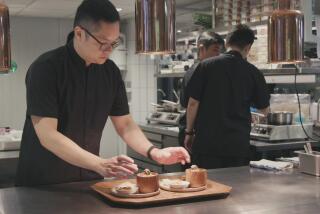Positively charming Singapore
Mention this tiny island nation off the tip of the Malay Peninsula and Americans may envision a prim, repressive society that puts drug dealers to death, censors movies and TV, and fines ordinary citizens for chewing gum.
That’s unfortunate, because this former British trading colony of 4.6 million, now an international financial and high-tech hub, is surprisingly convivial and has much to offer: world-class nature parks and museums, an exciting Pan-Asiatic cultural blend, unique cuisine, sparkling high-rises and diverting ethnic enclaves.
And you can chew gum, under recently relaxed rules. Just make sure it’s sugarless and teeth-whitening — the only kind that can be sold. You can also view HBO’s naughty “Sex and the City,” albeit with racier parts excised.
I learned all this during four days on the tropical island earlier this month. I went with my partner, Wesla, as part of a seven-day package to Singapore and Hong Kong that totaled just $2,508 for two, including airfare from L.A.
Our package was among many bargains designed to jump-start tourism after outbreaks of SARS hit Singapore and several other Asian nations. At the scare’s height this spring, visitor arrivals here sank to a quarter of normal. The World Health Organization declared the outbreak contained in Singapore in May and worldwide in July.
The discounts and bargains have helped Singapore regain many of its visitors. That’s a welcome development for a usually prosperous country that has been losing business to lower-wage nations and recently logged its worst economic contraction on record.
As we left Singapore, a new SARS case was diagnosed in a laboratory worker, clouding the future.
Such concerns were far from our minds on the half-hour shuttle ride from spotless Changi Airport to our luxury high-rise hotel. Instead we were enchanted by the lush jungle on both sides and down the highway median.
In the city too were oases of shady pocket parks, affording respite from a climate so steamy that it drove one famous 19th century visitor, Rudyard Kipling, to entreat his hosts, “Leave me alone and let me drip.”
The greening of Singapore is largely the work of its 20th century founder and now Senior Minister Lee Kuan Yew, dubbed by some the “monster gardener.” He’s also the architect of its (until recently) roaring economy and strict laws, designed to forge a modern Asian powerhouse from what was once a crumbling colony.
After a night in our comfortable 17th-floor harbor-view room at the Pan Pacific Singapore, which sports a soaring 35-story atrium and rooms with published rates starting at $228, we sampled the city’s past on a superb two-hour Chinatown foot tour run by Original Singapore Walks.
Yes, there is a Chinatown in Singapore, a predominantly Chinese city. You’ll also find a Little India and an Arab Quarter. They are legacies of Singapore’s colonial father, Sir Thomas Stamford Raffles, a British East India Co. officer who landed in 1819, laid out the city into ethnic zones and established it as a British trading post. The Raffles Hotel here bears his name.
Among other Raffles legacies are the so-called Five Foot Ways, covered walks about five paces wide that protect strollers from sun and rain in front of shop-houses (stores on the first floor, living quarters above) in Chinatown, home to generations of immigrant Chinese laborers. Highlights of our walking tour included the ornate 19th century Thian Hock Keng Temple, crafted without nails; a modern Chinese medicine store; and tiny but historic Sago Street, with its “wet market” full of tropical fruits, fish, live frogs and more.
For lunch, Wesla and I walked to Blue Ginger in Chinatown, a purveyor of Peranakan fare, the hybrid cuisine created by descendants of early Chinese immigrants who married Malay women.
For a total of $22 for two, we shared otak otak, a spicy fish cake wrapped in banana leaf; chap chye masak titek, mixed vegetables in prawn stock; fried bean curd; fresh lime juice; and durian chendol, a dessert made with a puree of the region’s notorious durian fruit. The puree smelled and tasted like a melon gone bad, but we downed a bit anyway. It must be an acquired taste.
Doing a fast-forward to contemporary Singapore, we spent the evening in and around Esplanade-Theatres on the Bay, Singapore’s $343-million contribution to cutting-edge architecture. Its shiny twin haborfront domes, opened last year and promptly nicknamed “the Durians” for their spiky surfaces, are not beloved by all, but I liked their quirky glamour.
The complex was also a hit with hipster couples on Saturday night dates, who swarmed its cafes and cuddled on outdoor benches. Many strolled over the Esplanade Bridge to Merlion Park, home of the water-spouting half-lion, half-fish statue that Singapore has adopted as its tourism symbol.
The next day we took in the new wing of the beautifully designed Asian Civilisations Museum, which opened in March just as SARS hit the news, in the restored 1860s Empress Place. There Wesla pursued a passion for shadow puppets, hopping between Indonesian, Chinese and Indian galleries to compare styles.
A lavish home for animals
Then it was off to the zoo. Actually two zoos: The Singapore Zoological Gardens on the northern side of the island and, next door to it, the Night Safari, which totaled about $16 for a combined ticket with tram ride. (Another bargain: Our half-hour cab ride there was less than $10.)Like the San Diego Zoo, Singapore’s main zoo is large and lavishly landscaped, with minimal barriers between animals and humans. It’s so humane that it recently treated its Komodo dragon lizard for a nerve disorder and depression with acupuncture. At last report, the patient was on the mend.
The Night Safari is unique: A tram takes you past softly illuminated natural environments where you can see flamingos prance, tigers prowl and hippos bathe. A footpath led us into a bat house, where the hanging denizens nonchalantly munched on melon and spread their wings. It was magical.
Our final day included a brief visit to the city’s serene Singapore Botanic Gardens; a stroll through colorful Little India, with lunch from fragrant food stalls ($3 total for two); and tea and a drink at Raffles Hotel, a late 19th century shrine of colonial history.
Raffles, wrote author-guest Somerset Maugham, “stands for all the fables of the exotic East.”
The hotel is still luxurious, although now nearly engulfed by a high-end retail arcade built during its 1989-91 restoration. (Singapore has so many malls that we joked it was one nation, under Gucci, with Armani and Versace for all.)
Afternoon tea in Raffles’ Tiffin Room was a self-serve buffet. The grand room and the food did not disappoint: salmon quiche, finger sandwiches, fresh fruit, scones and pastries, plus an assortment of dim sum and the Peranakan dessert soup buh buh cha cha, all for about $21 per person.
Afterward we headed upstairs to the Long Bar for a Singapore sling, a neon-pink concoction that includes gin, cherry brandy, Cointreau and pineapple juice.
It tasted like fruit juice and cost more than $10.
Our evening included another must-do: a half-hour bumboat (motorized sampan) cruise through the harbor and up the Singapore River, past the twinkling lights of Boat Quay and Clarke Quay cafes.
We met a few American visitors, most with family or financial ties to the city. Among them was Andrea Liebert, a Highland Park, Ill., audiologist on a weeklong trip to train hospital staff here.
Of SARS worries, she said, “It crossed my mind, but I thought since the ban was lifted, it was safe enough. But I’ve been washing my hands a lot.”
Liebert, among hundreds attending a Night Safari wildlife show, was the only volunteer willing to “wear” a live albino python. Clearly she was a fearless adventurer.
But Singapore is well-nigh irresistible to any traveler, and it doesn’t take an explorer to track down its charms.
*
(BEGIN TEXT OF INFOBOX)
Exotic tastes and scents
GETTING THERE:
From LAX, connecting service (change of planes) is available on Singapore, JAL, United, Northwest, Thai, Eva and Cathay Pacific. Restricted round-trip fares begin at $900. (Travelers may find better prices by buying a package.)
TELEPHONES:
To call numbers below from the U.S., dial 011 (the international code), 65 (code for Singapore) and the local number.
WHERE TO STAY:
Pan Pacific Singapore, Marina Square, 7 Raffles Blvd.; 6336-8111, fax 6339-1861, https://www.singapore.panpacific.com . Wonderful views of Marina Bay, the skyline and the water-spouting statue of Singapore’s icon, the Merlion. Doubles from $228.
WHERE TO EAT:
Blue Ginger, 97 Tanjong Pagar Road; 6222-3928. Peranakan cuisine, Singapore’s distinctive Malay-Chinese fusion, served in a restored shop-house in Chinatown. Entrees $7-$17.
Siem Reap II, 1 Empress Place; 6338-7596, https://www.indochine.com.sg . Cafe behind the stunning new Asian Civilisations Museum has an outdoor patio overlooking the Singapore River. We shared Khao Poon Nam Pa, spicy noodles with prawns and kafir lime leaves. Entrees $7-$11.
Tekka Centre, Serangoon and Bukit Timah roads, near Little India MRT (subway) station. This drab structure houses one of Singapore’s many food courts — basically street stalls moved indoors. Mainly inexpensive Indian and Muslim dishes. Fresh juices for 60 cents, fish curry for $1.65.
Tea Chapter, 9 and 11 Neil Road; 6226-1175, https://www.tea-chapter.com.sg . Claiming to be the largest teahouse in Singapore, this multistory Chinatown haven doesn’t just serve tea; it shows you how to drink it. Our brief tea introduction cost about $3 a person. Next door is a fine store that sells tea, teapots and related paraphernalia.
Tiffin Room, Raffles Hotel, 1 Beach Road; 6337-1886, https://www.raffles.com . Buffet lunches and dinners, plus breakfast and tea, taken in two elegant, white-colonnaded rooms. We went for tea, a self-service buffet offered 3:30-5:30 p.m. daily. (Book two to three days ahead.) $21 a person.
THE ZOO:
Singapore Zoological Gardens, 80 Mandai Lake Road; 6269-3411, https://www.zoo.com.sg . You could easily spend a full day at this vast park. The main zoo is open 8:30 a.m.-6 p.m. daily; adult admission $7. Night Safari is a separate area with its own Web site, https://www.nightsafari.com.sg . View creatures by tram and on foot. Open 7:30 p.m.-midnight; adult admission $9. Combined ticket for both parts of zoo, with tram, $16.
WALKING TOUR:
The Original Singapore Walks, 24A Sago St.; 6325-1631, https://www.singaporewalks.com . This new service offers two-hour themed tours daily. No reservations required. Adults $8.50.
TO LEARN MORE:
Singapore Tourism Board, 4929 Wilshire Blvd., Suite 510, Los Angeles, CA 90010; (323) 677-0808, fax (323) 677-0801, https://www.tourismsingapore.com .
Jane Engle
*
(BEGIN TEXT OF INFOBOX)
HIGHLIGHTS
Culture and nature: Best of Singapore
Urban sophisticates and nature lovers can be equally content in Singapore, with its upscale shops, eclectic Asian cultural life and leafy retreats. Some iconic scenes from the island:
Singapore Botanic Gardens: “All the Englishmen in the island congregated there,” Rudyard Kipling wrote of this oasis more than a century ago. And they still do, along with many others. Don’t miss the National Orchid Garden, one of Asia’s largest.
Asian Civilisations Museum: This striking new facility is so Singapore, one of Asia’s great ethnic melting pots. Listen to gamelan music from Indonesia or admire a batik from Syria. Then stroll out back for a river view and a meal or snack at the cafe.
Singapore Zoological Gardens: One of the world’s great zoos is in two parts. One is a jungly park that puts few barriers between humans and other species. You can even have breakfast and tea with the wildlife. The other is the Night Safari, where visitors spy on beasts’ nocturnal doings.
— Jane Engle
More to Read
Sign up for The Wild
We’ll help you find the best places to hike, bike and run, as well as the perfect silent spots for meditation and yoga.
You may occasionally receive promotional content from the Los Angeles Times.






